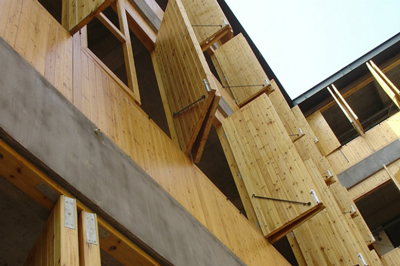You are in: Home page > Magazine Archive > Architecture of the necessity

Luca Reale
Architecture of the necessity

Wang Shu: Xiangshan School Campus of the Academy of Art, 2004-2007, Hangzhou, China. Photo by: Lu Wenyu
The financial crisis of summer 2007 and the resultant economic recession which continues today incidentally played their part in revealing a precise and perverse mechanism within our own profession as architects. A similar attitude which in previous decades had gradually transformed architecture from an urban phenomenon and a self-referential creative production, in fact simultaneously justified, over time, a progressive indifference on the part of architects concerning urban matters and processes of settlement dispersion. Which in some cases were observed very much “from on high” and with a certain satisfaction ‒ suffice to think of the endless analyses of the metropolisation of the land, the Po Valley conurbation, the Adriatic city, etc. ‒ while in other cases totally rejected, justifying planners dedicating themselves to niche themes or concentrating on the artistic nature of their own language, at this point taking the process of urban growth to be something obscure and ungovernable.
After years “objectualizing” architecture (which had become a prize-winner for its images or a mere display of technology), of progressively abandoning the link between architecture and the urban context with a consequent reduction in the distance between architectural artefact and artistic object, architecture and the urban project, now seem ‒ precisely because of the crisis ‒ to be once again approaching the questions of the city (and more in general its own context). Architecture is simply once more shifting its centre of gravity from art to necessity, without this automatically signifying a retreat into the local dimension, or a reduction in the project’s function of pure problem-solving, bringing back into fashion a sort of new functionalism. This necessity might be divided according to different acceptances of the term: inexpensiveness, efficiency and low environmental impact (that over-inflated “sustainability”), sharing of choices (the equally abused “participation”), maximum exploitation of the extant rather than consuming those lands and resources which have held out against urban and demographic development over the last century. Hence the city seems to be returning to regenerate itself through internal growth, as , at the end of the day has always been the case in urban history, at least until the settlement sprawl determined mainly by mass ownership of private motor vehicles.
Reasoning on the re-compacting of cities, on densification and reuse (or recycling, as it is now fashionable to say) of our urban centres is therefore the scenario upon which the architecture of necessity should be imposed, a way of thinking of the project without superfluous adjectives, focusing on the effective opportunity of the intervention while steering clear of the risk of redundancy or excess, using maximum economy of expressive means and at the same time going for quality and innovation. This does not necessarily imply de-growth (which is however a scenario we must begin to come to terms with), but changing our standpoint, learning to work with more difficulties and obstacles, availing ourselves in a more aware way of resources and technology and ‒ in a more ambitious way ‒ beginning to think of progress in a different manner.
If architecture is going to have to operate, but for some exceptions, on the complex and stratified horizon of the compact city, viable project operations within the urban fabric will amount to densification or restoration, the transfer of building density, the substitution/transformation of existing artefacts, the reuse and functional conversion of infrastructure, the public land project. All urban strategies with zero land consumption.
Lastly, necessity means returning to the central themes of our trade: residences, the public space, urban infrastructure. This demands an updated call for the ethical responsibility of our rôle, if it is still true, as Adolf Loos claimed exactly one century ago, that “[..]the work of art is brought into the world without there being a need for it. Instead, a house does fulfil a need. The work of art is not responsible to anyone, the house to everyone.”
Luca Reale is a Researcher in Architectural and Urban Composition at the Sapienza Faculty of Architecture in Rome













